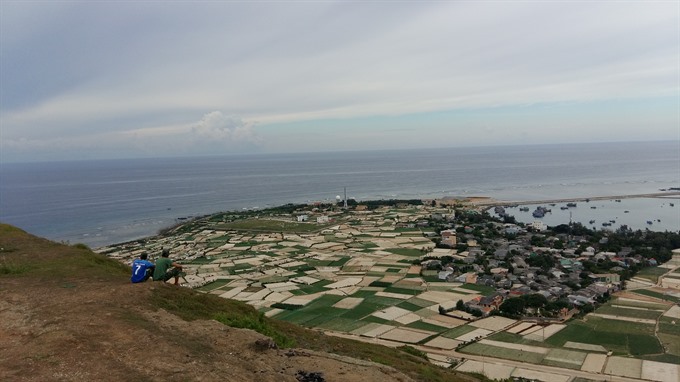Rapid development of resorts, hotels and entertainment projects in the Lý Sơn Island off the central coastal province of Quảng Ngãi threaten to seriously damage the ancient geography of the area related to volcanic eruptions 25 to 30 million years ago.

Peaceful: An overview of Lý Sơn Island is seen from Thới Lới Mountains. VNS Photo Công Thành
Biologists, scientists and geologists have raised concerns about plans to develop a big resort on the islands that would cover an area of 70ha, including 50ha of sea space in the Lý Sơn Marine Protected Area.
The island, 30km off the coast of Quảng Ngãi Province, is the remains of a volcanic eruptions dormant volcano, and the terrain of the island was structured from volcanoes millions years ago, leaving landscapes with rocks, caves, cliffs, rock arches and a lake.
In a recent working session with Việt Nam Infrastructure Investment and Development joint stock company (VIID), the central province’s people’s committee allowed investors to begin a survey on the project in the first quarter this year.
Director of the Việt Nam Institute of Geosciences and Mineral Resources, Dr Trần Văn Tân , told Việt Nam News that the province should carefully consider a decision to build the resort complex.
“A 70ha project, which would cover an area of sea and land, is really a large project on a small area.
The islands and a vast coast area of Bình Sơn district are being considered as a site for a Global Geo-Park for approval by UNESCO,” Tân said.
Tân, who is a geologist-geotechnical engineer, suggested that there were different ways for development, including sustainable eco-tour services and community-based tourism.
He said tourists came to explore the unique heritage of the islands and the volcanic structures left from eruptions million of years ago, but not to shop or stay at luxury hotels.
He suggested that the province should do its best to make sure the islands become a Global Geo-Park before planning of any resort or hotel projects.
Head of the Lý Sơn MPA management board, Phùng Đình Toàn, said he had not received any reports on the resort complex.
Toàn said the Lý Sơn MPA was one of 16 nationwide MPAs approved by the Prime Minister in a Master Plan to 2020. He said any development of investment project in the MPA must consider an approval from the management board in context of ecology system and environment.
He said the MPA, which covers more than 7,900ha including 7,113ha of sea water, was home to 700 marine fauna species (coral reefs, fish, seaweed, crustacean), of which 25 were endangered or in danger of extinction.
He said more than 400ha of land on the island had been seriously eroded by rising sea water in the past 40 years.
Researcher Chu Mạnh Trinh from the MPA of Chàm Islands, said ancient volcanic structures would be damaged if mass development of hotels, resorts and concrete buildings was allowed.
Trinh suggested the province could design the island as a site for day-time visits only, while entertainment, accommodation services, cuisine and shopping centres could remain on the mainland.
Geologist Vũ Cao Minh, also warned that exploitation of beach sand for farming garlic and onions could result in damage to coral reefs around the island, while the boom in hospitality services could lead to a mass collapse of the underground water structure of the island.
He said waste treatment, over-use of pesticides in farming and too many concrete structures would seriously affect the island’s landscape in coming years if no action was taken.
Deputy director of the VIID company, the resort complex project investor, Nguyễn Anh Tuấn, said: "We plan to build floating water villages and entertainment centres with anchored systems. They would need concrete bore piles on the coast to reinforce the anchor systems.”.
Provincial Party secretary, Lê Viết Chữ, said the province would reconsider the project.
Lý Sơn Island, which was designated as a community-based tourism site, has 109 hotels, guest houses and 56 home-stays with a total of 650 rooms. They can provide accommodation for more than 1,000 tourists a day.
The island is a tranquil destination with 21,000 inhabitants, most of whom make their living from farming garlic and spring onions and fishing. — VNS